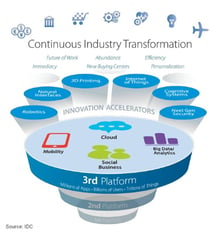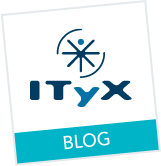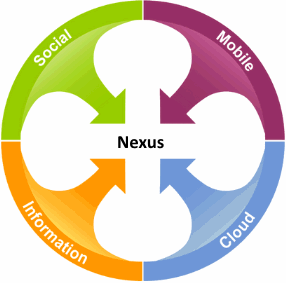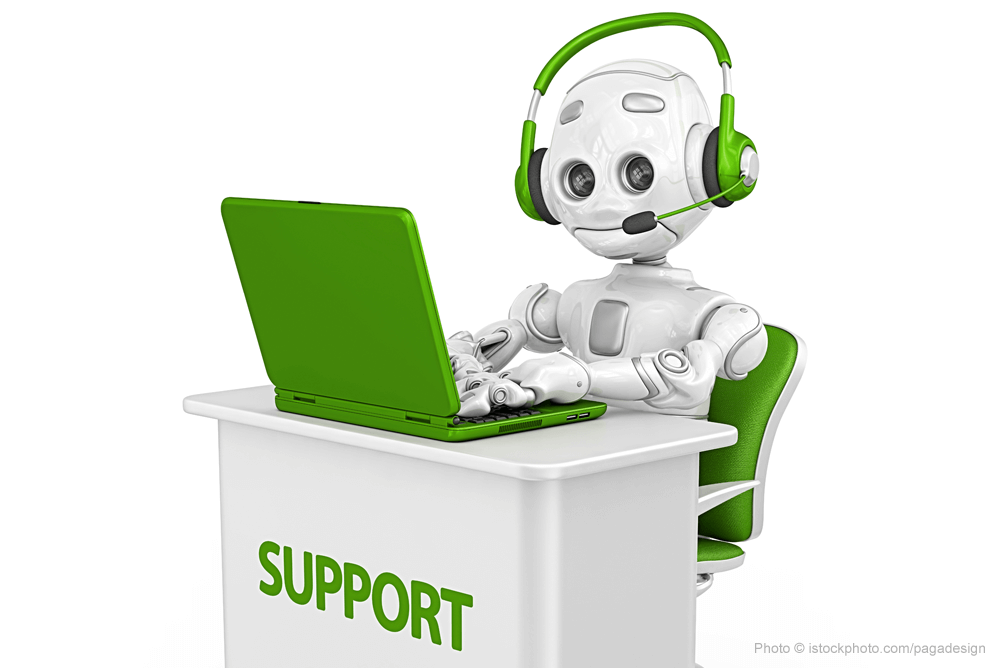The advent of the Third Platform (Big Data, Social, Mobile, Cloud & Analytics) has generated predictions of increasing innovation, accelerated disruption and broad application adoption. Many of them have come true, but the years ahead are about more than just keeping astride of the growth of third platform technologies. Instead, businesses need to keep their survival in mind. The ability to stay competitive and prosper is not guaranteed by simply embracing the benefits of third platform technologies or even putting the consumer first. One thing is certain: information management is one of the must-haves for a digital transformation strategy.
Innovation and Transformation accelerate at an Exponential Rate
 Continuous Industry Transformation (c) IDC
Continuous Industry Transformation (c) IDC
Companies in a variety of industries have shot ahead at a blistering pace. The “digital industrial revolution” now requires an increase in the pace of developments and innovations for any organization. It has never been more difficult to catch up to the industry leaders who have had the advantage of early adoption or groundbreaking innovations. The rate of development can be seen as exponential in many spaces. However, it is important not to see digital transformation as a marathon, but rather as a relay. In a relay, some runners are there to hold the pace while others are there to sprint ahead and gain an advantage. These sprinters, in the digital transformation relay, are responsible for swift change capacity for scaled transformation.
Let us take a look at the bigger picture before we focus on how the latest evolution will affect your organization. Ready, steady, go!
Spoiler alert: According to the IDC, two out of three CEOs of the G2000 companies will be making digital transformation a key element of their corporate strategy by 2017.
The Five Stages between Transformation Technology and the Transformation Economy
Stage 1: The rise of the third platform and digital business
Back in 2007, the IDC identified the third platform. It consists of four business/technology pillars: big data/analytics, cloud, mobility and social (business). Gartner chose to call it the “Nexus of Forces”. Along with others, the nexus is comprised social, mobile, analytics and cloud (SMAC). Names aside, the big takeaway from this is that industry thought leaders recognize these technologies and their widespread adoption (how they changed people’s behaviors and how they were leveraged to meet certain targets) are sending us all into a new business reality.
Stage 2: Innovation accelerators are the drive behind the third platform
The mainframe and the client-server model preceded the third platform. When the third platform came into existence, it was joined by technologies which the IDC termed “innovation accelerators”. Some of the technologies that accelerating innovation include natural interfaces, robotics, the Internet of Things, 3-D printing, next generation security and cognitive systems.
Stage 3: Moving from changing to making
The next wave of innovation has been driven by the experiences of stakeholders. The business drivers behind this include the digital customer experience, automation, optimization, speed, differentiation and cost reduction. In turn, this led to an innovation stage that requires information to fuel it. The best approach to digital transformation is one that uses IT and information excellence in tandem.
Stage 4: Faster and better innovation and transformation
In the coming years, the impact of disruptive business models will accelerate. The result, according to Frank Gens from the IDC, will be the public feeling the result of the disruptive impact that digital transformation will have. All this will requires enterprises to increase their initiatives in digital transformation. As the digital industrial revolution is happening, enterprises are jockeying for leading positions in the movement.
Stage 5: Digital transformation creating the DX economy
According to IDC, the digital industrial revolution or the digital transformation (DX) economy will give digital transformation a pivotal role in growth and innovation strategies for all industries across the board. Centralizing digital transformation strategies will be far-reaching and faster than ever experienced before. The key factors of this evolution will see a marriage between the traditional essentials of the third platform (cloud computing, big data, analytics etc.) and revolutionary elements (the Internet of Things, AI etc.).
Redefining Business Assets and exploring Hyper-connectedness
Organizations will invest in third platform technologies over the next few years. The concepts driving this investment include understanding customers, information and data as core assets and tools such as algorithms and code as the glue making it possible for these assets to deliver desired outcomes.
Aside from getting a handle on technology, acceleration and innovation, organizations also need to understand a few more things in order to really comprehend digital transformation. Keep in mind that with the seemingly separate evolutions taking place, digital transformation is essentially about hyper-connectedness in the truest sense.
The ten technologies often associated with the third platform are interconnected. They drive each the others, they impact and affect each other and the customer will use them in highly connected ways. For example, say your goal is to increase the use of the Internet of Things apps to improve your customer service. You would, in that case, need to increase contact or touch-points as well as feed the data pipeline- for that you’ll need big data/analytics and Artificial Intelligence.
Here are some examples of the common threads running through digital transformation. All demand different types of investment and focus from the C-suite.
- Data and information are what hold everything together. Information is one of the forces in Gartner’s Nexus of Forces it works alongside social, mobile and cloud.
- The cloud allows for a scaled approach for proliferating third platform technologies making it a vital part of digital transformation.
- Connected touchpoints and experiences are the driving force behind better customer communication. With tools communicating with each other and with the Internet of Things, there will be an explosive growth in touchpoints. This means that added to information, customer and user experience needs to include touchpoints as well.
- Digital transformation is about hyper-connectedness, it pulls devices, technologies, people and data into interaction that avoids silos. Digital transformation cannot happen with the same ideas of information management, ECM and customer service that persist today. “Holistic” is de facto “connected”.
The IDC predicts the most important Worldwide Digital Transformation trends and opens the FutureScape Web Conference Series.3
On Your Marks… Digitize and Automate now
The staged approach towards a digital transformation economy is also worth mentioning. It cannot all be done in one shot, but according to the IDC, the earlier you start the better. Your individual organization’s context and space will determine how and why you make the decisions about digital transformation. One company might find it relatively easy to adopt the cloud, while another could have real difficulties with this. The DX economy does not favor late adopters. It is important to get into the starting blocks and begin the race. The hurdles standing in the way of this happening need to be put aside of quickly.
A four-point preparation for this involves removing paper from all processes, removing costly manual tasks and processes, harmonizing and overcoming silos, and taking the lack of digital transformation leadership head-on.
Digital transformation leadership, when implemented properly, can identify important forces that drive digital transformation at a deep and meaningful level. This information can be used to understand how to remodel enterprises and remap industries. This process means that they will themselves affect leadership, making them more digital-centric leaders.4
1) The 3rd Platform is the new core of IT market growth
2) Gartner:The Nexus of Forces: Social, Mobile, Cloud and Information
3) IDC Reveals Worldwide Digital Transformation Predictions
4) Gartner: Three digital Forces





